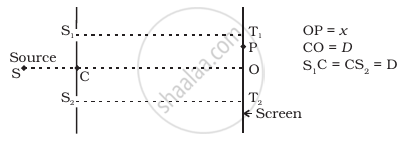Advertisements
Advertisements
प्रश्न
A slit of width 0.6 mm is illuminated by a beam of light consisting of two wavelengths 600 nm and 480 nm. The diffraction pattern is observed on a screen 1.0 m from the slit. Find:
- The distance of the second bright fringe from the central maximum pertaining to the light of 600 nm.
- The least distance from the central maximum at which bright fringes due to both wavelengths coincide.
उत्तर
(i) Distance of 2nd bright fringe from central maximum = `(2λ"D")/"d"`
= `(2 xx 600 xx 10^-19 xx 1)/(0.6 xx 10^-3)`
= 20 × 10−4 m
(ii) If nth bright fringe due to 600 nm coincides with (n + 1)th bright fringe due to 480 nm, then
`("n"λ_1"D")/"d" = (("n" - 1)λ_2"D")/"d"`
Or, nλ1D = (n + 1)λ2D
Or, `"n"/(("n" - 1)) = λ_2/λ_1`
Or, `"n"/(("n" - 1)) = 600/480`
`"n" xx 480 = 600 ("n" - 1)`
`480 "n" = 600 "n" - 600`
600 = `600 "n" - 480 "n"`
600 = `600 "n" - 480 "n"`
600 = `120 "n"`
∴ n = `600/120`
n = 5
So, the least distance from the central maximum = `(5 xx 480 xx 10^-9 xx 1)/(0.6 xx 10^-3)`
= 4 × 10−3 m
= 4 mm
APPEARS IN
संबंधित प्रश्न
In Young's double slit experiment, describe briefly how bright and dark fringes are obtained on the screen kept in front of a double slit. Hence obtain the expression for the fringe width.
Using monochromatic light of wavelength λ in Young’s double slit experiment, the eleventh dark fringe is obtained on the screen for a phase difference of ______.
A parallel beam of light of wavelength 500 nm falls on a narrow slit and the resulting diffraction pattern is observed on a screen 1 m away. It is observed that the first minimum is a distance of 2.5 mm away from the centre. Find the width of the slit.
Find the angular separation between the consecutive bright fringes in a Young's double slit experiment with blue-green light of wavelength 500 nm. The separation between the slits is \[2 \cdot 0 \times {10}^{- 3}m.\]
A mica strip and a polystyrene strip are fitted on the two slits of a double slit apparatus. The thickness of the strips is 0.50 mm and the separation between the slits is 0.12 cm. The refractive index of mica and polystyrene are 1.58 and 1.55, respectively, for the light of wavelength 590 nm which is used in the experiment. The interference is observed on a screen at a distance one metre away. (a) What would be the fringe-width? (b) At what distance from the centre will the first maximum be located?
In Young's double slit experiment shown in figure S1 and S2 are coherent sources and S is the screen having a hole at a point 1.0 mm away from the central line. White light (400 to 700 nm) is sent through the slits. Which wavelength passing through the hole has strong intensity?

Why is the diffraction of sound waves more evident in daily experience than that of light wave?
Consider a two-slit interference arrangement (Figure) such that the distance of the screen from the slits is half the distance between the slits. Obtain the value of D in terms of λ such that the first minima on the screen falls at a distance D from the centre O.

The maximum number of possible interference maxima for slit-separation equal to twice the wavelength in Young's double-slit experiment is ______.
In Young's double slit experiment, show that:
`β = (λ"D")/"d"`
Where the terms have their usual meaning.
